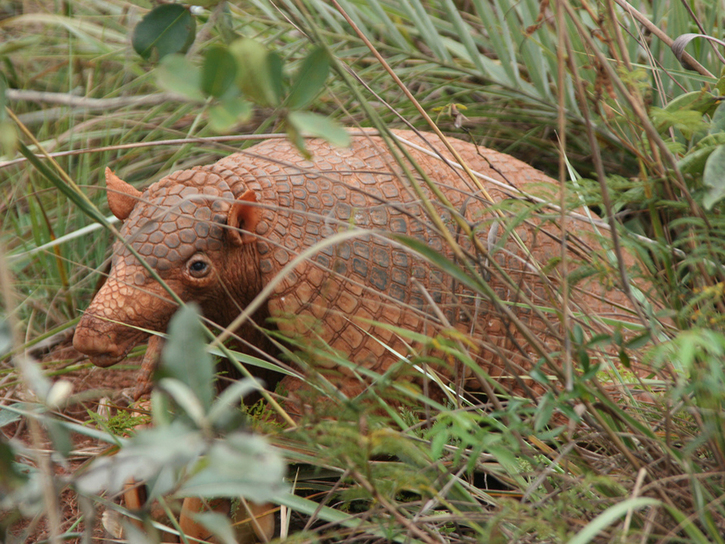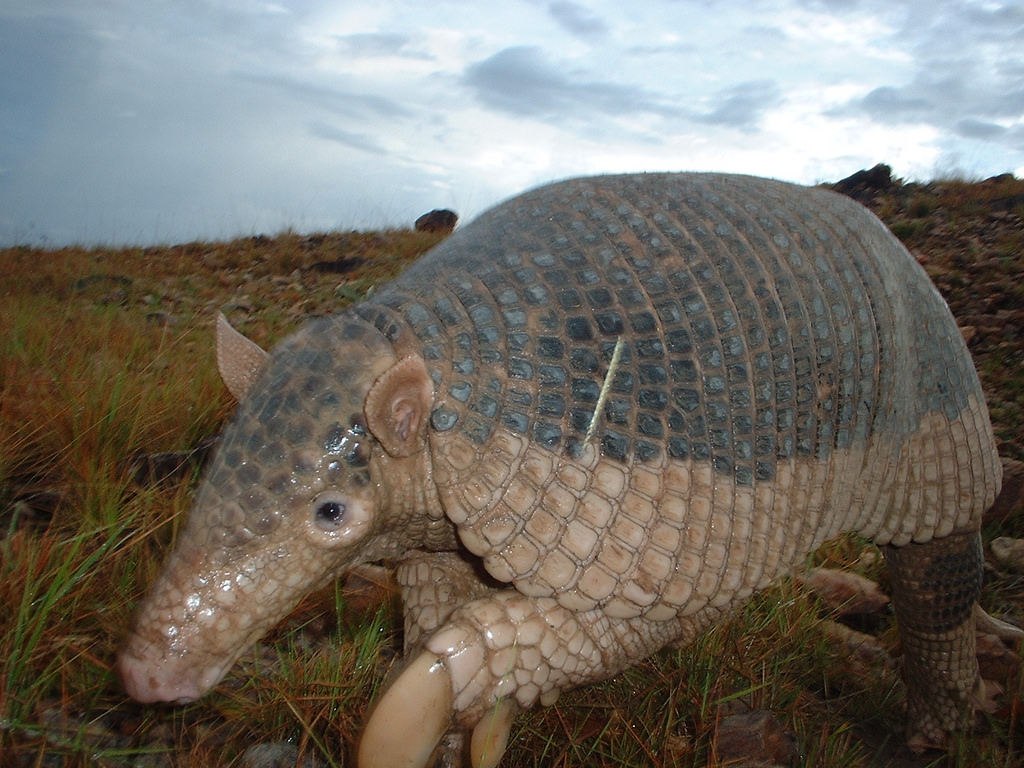This fascinating mammal can be quite intimidating because of its tough shell that is composed of boney plates in the dermis covered by horny scales. But when it is closely studied, it is admired for its many distinct features. The giant armadillo has eleven to thirteen hinged bands protecting its body and a further three or four on its neck. Its body is dark brown in color, with a lighter, yellowish band running along the sides, and a pale, yellow-white head.

Priodontes-Maximus | https://www.iucnredlist.org/species/18144/47442343
Features Of The Giant Armadillo
- Teeth: They have around 80 to 100 teeth, which is more than any other terrestrial mammal. The teeth are all similar in appearance, being reduced premolars and molars, grow constantly throughout life, and lack enamel.
- Claws: They have extremely long front claws, including a sickle-shaped third claw, which are proportionately the largest of any living mammal. Each front leg has 3 large claws.
- Tail: The tail is covered in small rounded scales and does not have the heavy bony scutes that cover the upper body and top of the head.
- Hairless: The animal is almost entirely hairless, with just a few beige colored hairs protruding between the scutes.
- Head: The head is conical and is protected by dome shaped armor with prominent leaf shaped ears on the top sides of the head.
- Weight and Length: They typically weigh around 18.7–32.5 kg (41–72 lb.) when fully grown, however a 54 kg (119 lb.) specimen has been weighed in the wild and captive specimens have been weighed up to 80 kg (180 lb.). The typical length of the species is 75–100 cm (30–39 in), with the tail adding another 50 cm (20 in).

Priodontes maximus – Tatu canastra – Joel Strong | https://www.flickr.com/photos/programaarpa/17025960498
The Giant Armadillo’s Diet
The giant armadillo prefers termites and some ants as prey, and often consumes the entire population of a termite mound. It also has been known to prey upon worms, larvae and larger creatures, such as spiders and snakes, and plants.
The Giant Armadillo’s Habitat
They primarily inhabit open habitats, with cerrado grasslands covering about 25% of their range, but they can also be found in lowland forests. They range from north of Brazil, Paraguay, southern Venezuela, the Guianas and the extreme north of Argentina, but regardless of their large range, they are rare in number. In Guyana, they inhabit savannah and rainforest and have a preference for watery areas, forest islands, bushlands and woodlands.
The Giant Armadillo’s Scientific Classification
Giant Armadillo – Priodontes maximus [Scientific name]
- Kingdom: Animalia
- Phylum: Chordata
- Class: Mammalia
- Order: Cingulata
- Family: Chlamyphoridae
- Subfamily: Tolypeutinae
- Genus: Priodontes
- Species: P. maximus
The Giant Armadillo’s Reproduction
They become sexually mature between 9-12 months but there is little known about reproduction. The female is known to give birth to a single young which is weaned between 4-6 weeks and the young will stay with the mother for about 6 months before becoming independent.
Tip: Giant armadillos are incredibly powerful and use their claws to dig their burrows and tunnels and they can tunnel surprisingly fast when escaping predators.
Burrows: Giant armadillos are fairly solitary and nocturnal, spending the day in burrows. The average sleep time of a captive giant armadillo is said to be 18.1 hours. They also burrow to escape predators, being unable to completely roll into a protective ball. Compared with those of other armadillos, their burrows are unusually large, with entrances averaging 43 cm (17 in) wide, and typically opening to the west.
Did You Know?
The giant armadillo is hunted for its meat; a single giant armadillo supplies a great deal of meat, and is the primary source of protein for some indigenous peoples.
Watch This
Giants Armadillos In Guyana
It is a privilege to have these well-built and study animals in Guyana. One was seen in the Iwokrama Rainforest and the other in the Kanuku Mountain Range. They are admired for their leathery armor shell, actually the word armadillo is Spanish for “little armored one”. They are also a great asset ecologically; they help to control the termite and ant populations within their ranges especially those of the Acoushi or Leaf-cutter ants. Although they are rare, they’re vulnerable, the World Conservation Union’s Red List in 2002 and Appendix I (threatened with extinction) of the Convention on the International Trade in Endangered Species of Wild Flora and Fauna has listed them vulnerable; their main threats being overhunting and habitat destruction. The unique features of the giant armadillo are indeed fascinating from head to toe. The amazing activities that they are involved in are intriguing; all contribute to making them the largest living species of armadillo in the world.
Article References:
- https://en.wikipedia.org/wiki/Giant_armadillo
- https://www.stabroeknews.com/2012/features/09/30/in-the-rainforest-giant-armadillo/
- https://www.kaieteurnewsonline.com/2011/12/11/the-armadillo/






